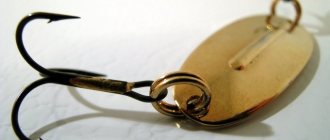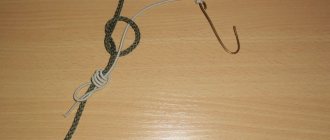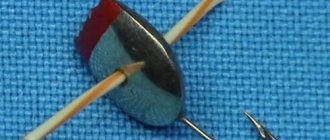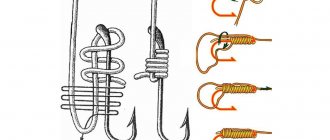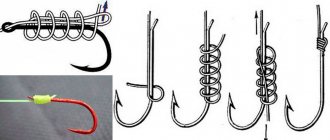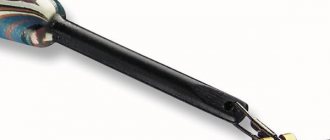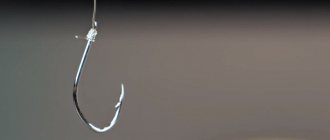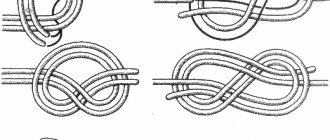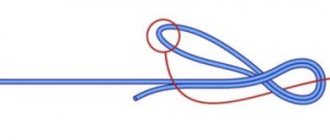In what equipment are fishing beads used?
2.1. The role of beads in float equipment
The most popular type of rig that uses beads is the float rig. When making such an installation, a variety of additional elements are used (beads, carabiners, knotless hooks, swivels, locking knots). It is impossible to do without these assistants, since they are not only an integral part of the equipment, but also ensure the safety of all structural elements.
Fishing beads are involved in the design of a sliding float, where their main function is to limit the depth of descent of the bait and unhindered passage through the rod rings. These small balls are located between the float and the stop knot, where they slide freely along the fishing line.
All the most important things about a sliding float: characteristics, shapes, types of fastening, conditions of use, selection rules for long casting and much more, read here
2.2. The role of beads in feeder montages
Rubber beads are also used in various rigs in feeder fishing. For example, in an installation using anti-twist tubes, two beads located at different ends of the fishing line after the tubes act as stoppers. The role of clamps is also assigned in such installations as “in-line” with a feeder.
For correct installation with a tap on a bead, see the Zamyatin Club channel
If you are interested in the topic of fishing stoppers, then this is the place for you
2.3. Beads in spinning rigs
2.3.1. Using beads in Texas rigging
The use of beads in the “Texas rig” is also justified. This type of equipment consists of a fishing line, an offset machine with a silicone worm, and a sliding bullet weight. A bead is placed between the offset hook and the bullet. In this case, the bead is not the main element of the equipment, however, thanks to the noise effect created by tapping the bead on the weight, the prey begins to be interested in the bait.
2.3.2. The use of beads in the Carolina rig
In the “Carolina rig” installation, the bead is a mandatory accessory, as it protects the fishing knot that connects the leash to the cord from the impact of the load so that it does not break. Additionally, just like in the Texas rig, the bead creates a noise attraction for prey by tapping on the sinker.
2.3.3. The use of beads in equipment when fishing with bombarda (sbirulino)
In this installation, one rubber bead plays the role of a retainer, that is, a fishing stopper, which is strung on the main fishing line in order to limit the movement of the float (bombard) towards the tackle. The second bead acts as a shock absorber, protecting the fishing swivel from being struck by the float when casting the equipment, thereby increasing the life of the attachment point.
2.4. Beads in sea bottom montage
Paternoster is a rig with side fishing leashes, common among anglers who are keen on sea bottom fishing in plumb and freshwater feeder fishing.
In this type of equipment, beads secured between crimp tubes secure the swivel to which the fishing leash is attached.
The diverter leads are fastened using beads with a special cross-shaped hole, the name of which is “cross bead” or “2 way bead” (the name is used less frequently). Sea fishing, just like freshwater fishing, is based on the development and selection of a specific installation for specific conditions; beads with a cross-shaped hole for finding the most catchy equipment are very suitable, since the installation of fishing diverter leashes with beads allows us to make universal bases for the paternoster.
This is what a cross bead looks like
The main thing in fastening fishing beads is their free rotation on the fishing line. Here you should pay attention to the size, which can be as follows: large (large), medium (average), small (small). The diameter of the holes themselves is determined at random, since the manufacturer does not mention it in the description. The main thing here is that the leash passes through the thread of the bead more tightly, then the knot securing the leash will hold it more reliably.
2.5. Beads in a carp montage
Beads in a carp “helicopter” montage
Carp installation for float tackle
How to increase your fish catch?
Over 7 years of active fishing, I have found dozens of ways to improve the bite. Here are the most effective ones:
- Bite activator . This pheromone additive attracts fish most strongly in cold and warm water. Discussion of the bite activator “Hungry Fish”.
- Increased gear sensitivity. Read the appropriate manuals for your specific type of gear.
- Pheromone -based lures .
- Thread - easy to install, but require constant tightening of the knot;
- Rubber or silicone balls or nipple pieces are available for different diameters of fishing line, which should be passed through them twice;
- Locking units are mounted at the fishing site when preparing equipment.
We knit stopper knots
When tying knots, be sure to wet the line so that when tightening it does not burn out from the frictional force of tension.
There are several types of tying stopper knots for a sliding float. Let's look at the 2 simplest ones:
Single stop knot
To tie this knot, you need to make a loop from the fishing line for the stopper, which is placed on the base fishing line. Then thread it through the loop and make 6-8 full turns around both lines. Tighten the knot. Cut off the rest, but not too short, leaving 3-5 cm tails.
Kremkus – double knot-stopper
Fold the stop line in half and make a few turns around the main line. The next step is to form a loop around which the ends of the fishing line wrap. The knot is tightened, the excess ends are cut off. This type of knot is thicker and holds better.
The remaining ends of the fishing line should not be cut off too much; long tails slip through the rod rings more easily than short, rough ends sticking out to the sides.
Video instructions for tying knots
We bring to your attention video instructions for tying another type of locking knot. You can clearly see how easy it is to tie a simple Clinch stopper knot. Practice tying this knot with your instructor, and you won’t have any problems while fishing.
What is the best material to knit stopper knots from?
Among fishermen, a locking knot for a sliding float, mounted using a thread with beads, has proven itself well. In this case, the line is pulled through the tube and the stopper is tightened. For better visibility, the threads need to be chosen in bright, contrasting colors; visibility and clear movements along the fishing line are the advantages of this type of stopper. Sometimes the thread can slip or unravel on its own, which is a significant drawback.
Please note that even the best quality stops can slip, so get a waterproof felt-tip pen to mark the length of the trigger. The knots do not cut into the float gear, so the likelihood of slipping is low. A big plus of knots is that they can be tied while assembling fishing equipment without prior preparation. Every fisherman should have a technique for tying stopper knots.
Material for making fishing beads
Fishing beads are made from various types of materials: silicone, glass, ceramics, plastic, etc. The use of beads made of a specific material depends on the type of fishing. For example, in installation with a sliding float, ceramic beads are used, which do not have sharp edges and are quite heavy, which can be very important.
Beads made of plastic and glass are used by fishermen for fishing with jigs, however, for example, plastic fishing beads have a disadvantage because they are light in weight, which causes them to stick on the fishing thread, slip through the rings of the tackle, which can lead to breakage of the equipment. Glass beads tend to break. Also, round pieces of glass cannot be quickly changed at the time of fishing, since they are put on the shank of the fishing hook before preparing the jig tackle.
Are you interested in the structure of a fishing float, its characteristics and want to know how the elements of the float affect the fishing process? - then read this article
Application area
The range where this element of equipment can be used is quite wide, for example, for a feeder or a sliding float.
Feeder equipment
To detect gentle and weak bites, you need equipment of a very sensitive design. One of the most unpleasant moments in the feeder is when you pull out a sucked bait, the fish eats the bait, and you don’t even notice. This is especially noticeable when fishing with a feeder in the current using heavy feeders.
To detect such bites, feeder equipment was invented using an elastic band as a shock absorber. Plug rubber is used, since it is commercially available and you can choose different diameters. The diameter is selected according to the strength of the current; a stronger current means a larger diameter.
A stopper is used to limit the stretching of the rubber. The elastic should stretch at the bottom until it stops. For example, a cambric can serve as a stopper.
Using beads as bait
In winter, during a period of low fish activity, jig fishing can be not only exciting, but also original. Thus, several small beads attached to a fishing thread at a certain distance can arouse the interest of future prey.
How it works? It's simple. The beads are attached to a fishing line, for example, for catching perch, at a distance of no more than 30 cm from each other, forming a kind of colored garland. When you throw the “garland” into the water, it begins to move smoothly, reminiscent of natural bait. You need to play with the tackle from the bottom to the top of the hole. The game takes place in a vertical position. To achieve the best result, you can tie a loop in the places where the bead is attached, onto which you attach a bloodworm.
What is the advantage of this type of artificial bait like a bead? Firstly, the color and size variety of beads. Secondly, it's cheap. Thirdly, durability of use.
A common disadvantage of beads used directly as bait is the difficulty in selecting the desired combination of catchable colors for specific fishing conditions. To do this, the fisherman needs to have several jigs in stock or spend his time selecting the right combination, and this is very problematic to do on a persistent frosty day.
7.1. What are the requirements for beads attached to a jig?
The attachment made from artificial beads must be ideal and meet the following requirements:
- strength to withstand catching more than one fish;
- ease of replacing beads;
- ideality in a round shape, which would not twist the fishing line when quickly reeling it out of the water or idle hooking;
- variety of sizes and colors;
- naturalness, that is, to be as close as possible to the inhabitants of the reservoir;
- be silicone.
7.2. How to make silicone beads with your own hands
To make the perfect bait beads, you need to stock up on some types of silicone baits, for example, vibrating tails and twisters of various colors.
What else will you need for production:
- sewing needle;
- cold water (1 glass is enough);
- gas stove.
Manufacturing instructions:
- Cut the silicone baits so that you get cubes ranging in size from 1 to 4 mm. This size will determine the size of the bead in the future.
- Then prick the cube onto the needle in the center so that the tiny tip of the needle peeks out.
- Place a glass of water near the gas burner.
- Take a needle with a cube and bring it to the fire.
- Rotate the cube evenly (like a kebab) over the fire.
- After the cube has acquired the desired shape, it should be immersed in cold water, so it will cool and harden.
- The nozzle is ready.
7.3. How to attach beads to a jig
Evgeniy will tell you in detail how to attach a bead to a jig.
7.4. How to attach beads to fishing line
The most optimal and reliable way to tie a bead is considered to be a method in which the fishing line is passed through the central hole in the bead twice and secured with a double knot. With this method, firstly, the direction of the fishing line is maintained and secondly, the reliability of the connection is ensured.
useful links
https://mas-te.ru/sovetyi-masteru/biser-v-pomoshh-ryibolovu/ - an interesting article about fishing beads and seed beads;
https://seatackles.blogspot.com/2011/11/blog-post_23.html - article about paternoster - equipment for sea bottom fishing;
https://salapin.ru/articles/article758.html - an informative article about artificial baits;
https://housecomputer.ru/rest/fishing/books/entsiklopediya_sovremennoy_ryb/21_vmesto_zaklyu4eniya/2.html - about beads from the Encyclopedia of Modern Fishing.
Attaching the fishing line to the fishing rod using a connector
Fly fishing rods from most branded manufacturers have a tip without a built-in ring. It is assumed that the only and correct way to attach the fishing line will be through a special connector, which can be purchased separately at any fishing store.
The size of the connector is selected depending on the diameter (thickness) of the tip. The connector also differs in type of construction depending on whether the tip of the last bend is hollow or not. The inner one is inserted inside the tip, and the outer one is placed on top. Attach it with simple glue.
The connection is made using a loop on a fishing line, which is threaded into a special fastener. To prevent the line from slipping off, there is a special protective cap that covers the hook of the connector.
When purchasing it, you need to pay attention to the quality of workmanship. The entire surface should be perfectly smooth, without any sagging or burrs that will cause the line to fray.
The cap must tightly close the hook, otherwise during fishing it will be annoying to lose all the equipment, including when biting a trophy fish. Most connectors are made of plastic. It is more fragile and can break if handled carelessly.
Metal products are more reliable, but if they come into contact with water, they can become rusty over time.
The connector is the most popular compared to other fastening methods because it is reliable and allows you to easily change equipment.
